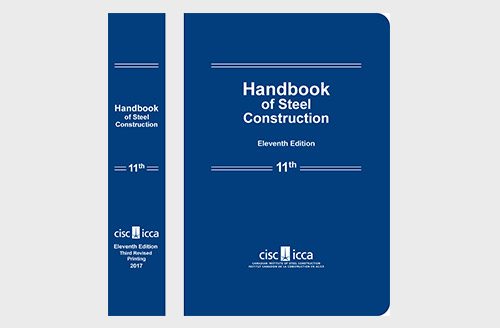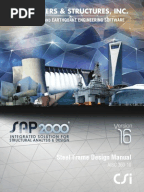Cisc Handbook Of Steel Construction 10th Edition
The Certificate in Structural Engineering Program offers courses on a wide range of structural engineering topics. In addition to promoting obtaining the Certificate in Structural Engineering, we also welcome auditing of courses:. Credit: Take a course with the goal of obtaining the Certificate in Structural Engineering.
'Handbook of Steel Construction - Seventh Edition' (C 1997 by Canadian Institute of Steel Construction) '350W' on cover First Printing November 1997 Price: negotiable Condition: Very good. The cover is very durable. The part covering the spine is slightly bumpy, but intact. Dec 10, 2012 - CISC June 2007 Handbook of Steel Construction 9th Edition, 3rd Revised Printing 2007 REVISIONS Inten1057928. This file you can free download and review.
Audit: Take a course to expand your knowledge, without the requirement to be evaluated. Minimum requirements to obtain the Certificate in Structural Engineering Each student must pass 12 courses; at least six of these must be from the list of. The balance of the course may be from either the list of.
July 10, 2017 (Chicago, IL) – The American Institute of Steel Construction’s (AISC) 15th Edition Steel Construction Manual is now available. This new edition of the Manual includes the 2016 Specification for Structural Steel Buildings, with improvements and revisions in the provisions for slender-element compression members, shear strength and double angle and WT flexural strength, as well.
The passing mark in each course is 68%. Given that the purpose of the program is to help develop professional structural engineers, we encourage students to achieve at least a 75% mark. Requirements for auditing courses Auditing a course requires regular class attendance. Audit status will not be granted where this requirement is not met. Auditing students are not required to (but are welcome to) take examinations. Core Courses. Elective Courses.
Course Descriptions C1 Analytical Methods in Structural Engineering Purpose: This is one of two courses intended to provide students with practical and effective means of analyzing a wide range of structural forms. This course will develop the student's ability to solve common structural analysis problems using strength of materials and approximate methods. The focus is on simple hand techniques that will provide the student with the ability to perform analyses for preliminary and conceptual design and to verify the results of direct stiffness and finite element models. Selected Topics: Beams on elastic foundations; frame analysis by moment distribution method; analysis of braced frames; shear and flexural deformations of walls and diaphragms; modeling building cores; lateral stability of columns and beams; strength and stiffness requirements of bracing; cables and tension structures; flexible piles and footings; shear lag; eccentric loads on welds, bolt and nail groups.
C2 Effective Structural Modeling Purpose: This course will develop the student’s ability to solve common structural analysis problems using commercial frame stiffness and finite element software. The focus is on building efficient and effective computer models that are truly representative of a structure’s behavior under loading.
Steel Construction History
Access to a standard desktop computer is required. Students will receive version 10L of S-Frame® software (limited capacity educational version) by S-Frame Software Inc.
As part of the course materials. Selected Topics: Frame analysis concepts; introduction to the finite element method; frame structures; walls and diaphragms; roofs, floors and slabs; beams on elastic foundation; foundations and soil-structure interaction; special material property considerations. C3 Topics in Practical Structural Design Purpose: This course is designed to help the student improve their experience in structural engineering. Issues addressed in the course will help familiarize the student with common challenges in the design office. Various typical design problems will be dealt with in class and may become the focus of homework or of exams. Together in class and as homework projects students will develop some systemized approaches for such tasks as column design, beam design, slab and slab band design, etc. Presenters will offer guidance and comments from their experience in consulting practice aimed at helping students understand the world of consulting and their career progression.
Students need to be familiar with building structures, design procedures and consulting office environments to get the most benefit from the class. Access to 2-dimensional structural analysis and spreadsheet programs is required. Selected Topics: Column load takeoff and design; field issues affecting design; slab and slab band systems; interface shear; deflection compatibility concerns; vibration and sound transmission in structures; drawbacks and problems using finite element and 3-dimensional design programs; detailing rebar in concrete structures; load paths; lateral load issues; specialty engineering responsibilities; over-conservatism in design; significant figures; dead load eccentricity; etc. C4-1 Introduction Earthquake Engineering and Seismicity Purpose: This course covers fundamental concepts of earthquake engineering and will provide the student with a background necessary for understanding and performing seismic analyses and design of building structures covered in other courses of this program. Selected Topics: Causes and effects of earthquakes, how earthquake forces are developed and resisted; seismic response of simple structures and the concept of response spectrum; seismicity of Canada, earthquake hazard, background of uniform hazard design spectra; design philosophy (ductility, seismic vs. Wind effects); fundamentals of dynamics for multi-degree-of-freedom systems; NBCC seismic provisions – base shear formula; seismic force distribution; torsional effects; soil effects on seismic response; irregular structures; parts of buildings (nonstructural elements, pipelines); diaphragms and their effect on seismic response, modern technologies for controlling the seismic response of structures.
C4-2 Advanced Concepts in Earthquake Engineering and Seismicity Purpose: This course covers advanced concepts of earthquake engineering and will provide the student with additional knowledge to perform seismic analyses and design of building structures covered in other courses of this program. Selected Topics: Seismic Hazard Analysis Concepts (Deterministic and Probabilistic), Basic Modeling of Structures for Seismic Analysis, Nonlinear Static Pushover Analysis, Nonlinear Dynamic Response History Analysis, and Soil-Structure Interaction. For each topic to be discussed, the theory behind the concept will be introduced and explained first, and then illustrative practically-oriented examples will be presented and discussed. C5 Conceptual Structural Design Purpose: Structural concepts arise in business and commercial development, architecture, process design, mine development, contracting, and many other specialties. Conceptual structural design for this course means the design of concepts within the realm of structural engineering, i.e. After architectural objectives are set and those constraints that are dictated by others are set. The course objective is to develop skills in the initial concept design phase of structural design for the overall structural concept, the choice of materials, and the concepts for details in a structure.
Cisc Handbook Of Steel Construction 10th Edition Free



Case studies will be used as examples to illustrate. Selected Topics: Approximate structural analysis fundamentals; form and function, common proportions, concept evaluation, innovative concepts (Beaver Bridge erection, Prince George); effective building concepts (developing concepts in wood and steel structures); high rise buildings (Shangri-La); institutional buildings (schools), conceptual concrete building design; seismic upgrade (Coquitlam Arena); learning from structural failures (Save-On Foods, Ironworkers Memorial Second Narrows Bridge and others).
C6 Dynamic Analysis of Structural Systems Purpose: The 2012 British Columbia Building Code recognizes dynamic response spectrum as the default analysis technique for seismic design of buildings; to carry out an effective seismic design structural engineers should have a solid understanding of the fundamentals of dynamic analysis. This course aims to give each participant a grasp of practical issues involved in analyzing/designing structures for dynamic vibration and earthquake loads.
The application of Mathcad and commercial structural analysis programs in solving dynamic problems is demonstrated.